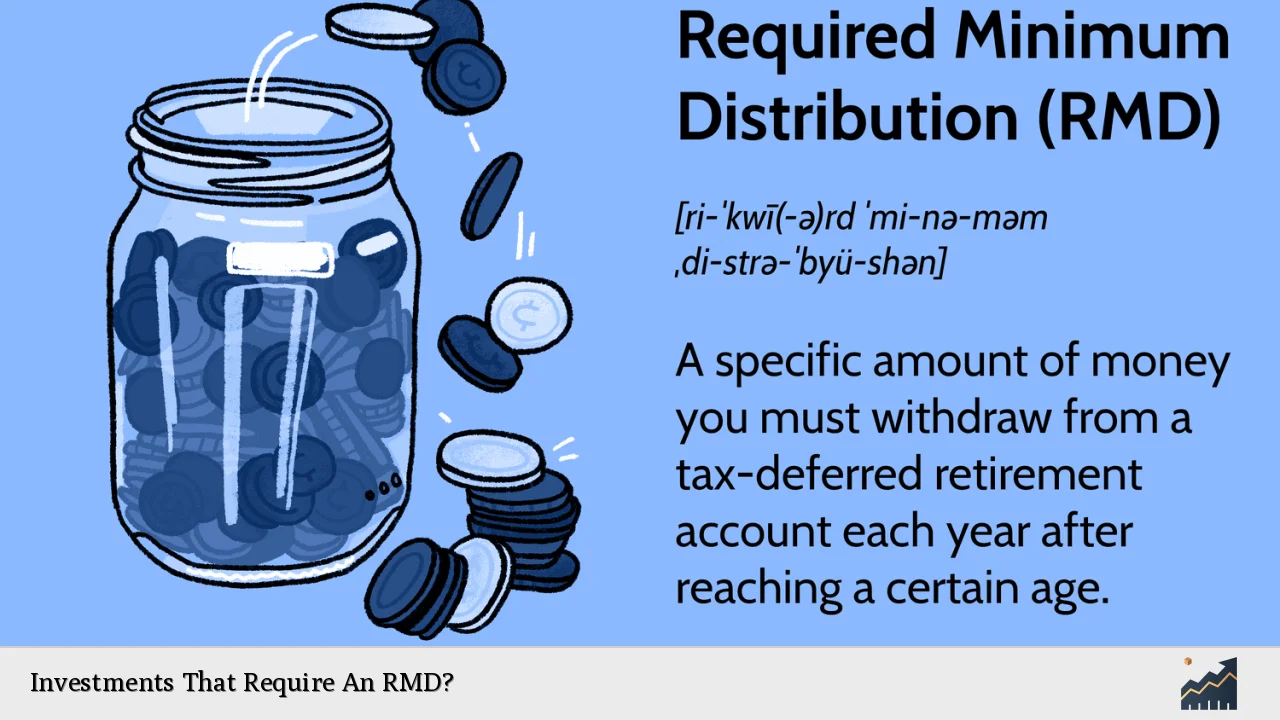When individuals reach a certain age, they are mandated by the IRS to withdraw a minimum amount from their retirement accounts. These withdrawals are known as Required Minimum Distributions (RMDs). The RMD rules apply primarily to tax-deferred retirement accounts, which allow individuals to defer taxes on their contributions and earnings until withdrawal. Understanding which investments require RMDs is crucial for effective retirement planning and avoiding hefty penalties.
The IRS requires that RMDs begin at age 73, as per the changes enacted by the Secure 2.0 Act. This age will increase to 75 starting in 2033. The first RMD must be taken by April 1 of the year following the individual’s 73rd birthday, while all subsequent distributions must be taken by December 31 each year. Failure to comply with these requirements can result in a significant penalty of 25% on the amount not withdrawn.
| Account Type | RMD Requirement |
|---|---|
| Traditional IRAs | Yes |
| Rollover IRAs | Yes |
| 401(k) Plans | Yes |
| 403(b) Plans | Yes |
| SIMPLE IRAs | Yes |
| SARSEP IRAs | Yes |
| Designated Roth Accounts (401(k), 403(b)) | No (from 2024) |
| Roth IRAs | No (during owner’s lifetime) |
Types of Investments That Require RMDs
Understanding which accounts require RMDs is essential for retirees. The primary types of investments that mandate RMDs include:
- Traditional IRAs: These accounts require annual withdrawals starting at age 73. Contributions are typically tax-deductible, and taxes are paid upon withdrawal.
- Rollover IRAs: Similar to traditional IRAs, rollover accounts also require RMDs once the account holder reaches the specified age.
- 401(k) Plans: Employer-sponsored plans like 401(k)s require participants to take RMDs starting at age 73, regardless of whether they are still employed.
- 403(b) Plans: These plans, often used by non-profit organizations and educational institutions, also have RMD requirements.
- SIMPLE IRAs and SARSEP IRAs: Both types of accounts necessitate RMDs once the account holder reaches age 73.
- Designated Roth Accounts (401(k), 403(b)): While these accounts were subject to RMDs until recently, starting in 2024, they will no longer require distributions during the original owner’s lifetime.
It is important to note that Roth IRAs do not require RMDs while the original owner is alive. This feature makes Roth IRAs an attractive option for those looking to minimize taxable income during retirement.
Timing and Calculation of RMDs
The timing for taking RMDs is crucial for compliance with IRS regulations. The first distribution must be taken by April 1 of the year following the individual’s 73rd birthday. Subsequent distributions must occur by December 31 each year thereafter.
Calculating the amount for an RMD involves determining the account balance as of December 31 of the previous year and dividing it by a life expectancy factor published by the IRS. This factor varies based on age and can be found in IRS tables.
For example, if an individual has a traditional IRA with a balance of $500,000 at year-end and their life expectancy factor is 25.6, their RMD would be calculated as follows:
$$
text{RMD} = frac{text{Account Balance}}{text{Life Expectancy Factor}} = frac{500,000}{25.6} approx 19,531.25
$$
This means that the individual would need to withdraw approximately $19,531.25 from their IRA that year.
Penalties for Non-Compliance
Failing to take an RMD can lead to severe financial penalties. If an individual does not withdraw the required amount or misses the deadline, they may face a penalty tax of up to 25% on the shortfall amount. For instance, if an individual’s required distribution was $10,000 but they only withdrew $5,000, they would incur a penalty on the remaining $5,000.
To mitigate this risk, individuals should establish a systematic withdrawal strategy well before reaching age 73. Setting up automatic withdrawals can help ensure compliance with RMD requirements and reduce the risk of penalties.
Strategies for Managing RMDs
Managing RMDs effectively can help retirees optimize their tax situation and investment strategy. Here are some strategies:
- Reinvesting Withdrawals: If retirees do not need their RMDs for living expenses, they can reinvest these funds in taxable brokerage accounts. Although this does not reduce current taxes, it may provide more favorable capital gains treatment in the future.
- Qualified Charitable Distributions (QCDs): Individuals aged 70½ or older can donate up to $100,000 from their IRA directly to charity without incurring income tax on that amount. This strategy can satisfy all or part of an individual’s RMD while benefiting charitable organizations.
- Converting to Roth Accounts: Converting traditional IRA assets to a Roth IRA may eliminate future RMD requirements since Roth IRAs do not mandate distributions during the owner’s lifetime. However, this conversion is taxable in the year it occurs.
- Adjusting Asset Allocation: As market conditions change, retirees may want to adjust their investment portfolios using funds from their RMDs to rebalance their asset allocation according to their risk tolerance and financial goals.
FAQs About Investments That Require An RMD
- What is an RMD?
An RMD is a mandatory withdrawal from certain retirement accounts once you reach age 73. - Which accounts require RMDs?
Accounts such as traditional IRAs, rollover IRAs, and most employer-sponsored plans require RMDs. - When do I need to start taking my first RMD?
Your first RMD must be taken by April 1 following your 73rd birthday. - What happens if I don’t take my RMD?
If you fail to take your required distribution, you may incur a penalty tax of up to 25% on the shortfall. - Can I reinvest my RMD?
Yes, you can reinvest your RMD in a taxable account if you do not need it for immediate expenses.
Understanding which investments require an RMD is essential for effective retirement planning and compliance with IRS regulations. By being aware of these requirements and implementing strategic withdrawal plans, retirees can navigate their financial futures more effectively while minimizing tax liabilities and penalties associated with missed distributions.

